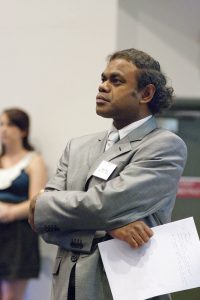For those of us who believe that the world’s wealthiest countries have a moral duty to give aid and to give it well, the present is an encouraging time to be engaged with Australian aid. Not only is the Australian aid budget forecast to double in coming years, but at least some of the problems that have bedeviled AusAID in the past are being addressed, and — perhaps most important of all given the complexities of aid — there seems to be intellectual engagement within the agency on a range of key development issues.
This much was on evidence on 7th February during the Development Policy Centre’s ‘Doubling Australian Aid’ conference at the Crawford School. Not only was the conference itself a good sign of intellectual exchange between AusAID, civil society and academia, but the breadth of issues covered was evidence (to me at least) that the Canberra development community has being doing some serious thinking about making aid work.
A particularly pleasant surprise for me was the talk delivered by Peter Baxter, the Director General of AusAID. The pleasant surprise wasn’t that I agreed with everything he said (I didn’t) but rather that the talk was substantive. This, to be honest, is not what I’ve come to expect from talks from people in roles like Baxter’s. As often as not their talks are designed with risk aversion in mind and carefully avoid saying anything much. But, in my opinion at least, this wasn’t the case at the conference; his talk touched on a range of interesting topics. I’ve discussed three of those that I personally found particularly interesting below (and to be extra clear, these are my interpretations of his comments, not quotes).
Bigger and Better
 Currently Australia is in the enviable position of having something akin to bipartisan agreement on aid, both with regards to increasing the aid budget and with respect to making aid work.
Currently Australia is in the enviable position of having something akin to bipartisan agreement on aid, both with regards to increasing the aid budget and with respect to making aid work.
Baxter’s most interesting comment in this area was that the aid programme won’t be able to grow in size unless it improves in quality too. Unless AusAID can show results, public support for increased aid is likely to wither. On this, Baxter is almost certainly correct and he had an impressive selection of statistics — from education in Indonesia, and vaccinations in Papua New Guinea, to maternal health in Cambodia — to show that Australian aid is achieving results.
It was heartening to see these sort of figures but, if I can play the role of pessimist for a minute, coming up with ongoing evidence of success is going to be much harder, and more problematic than it seems at first glance (and this is assuming, of course, that there will be successes to report on).
Part of the problem here is neatly encapsulated in the the old saying that, “not everything that matters can be counted, while not everything that can be counted matters”. Often, the easiest things to measure in aid are outputs (numbers of schools built) not outcomes (numbers of children who are well educated). And yet, ultimately, it’s outcomes that matter. Similarly, if AusAID becomes too driven by the need to report positive results, there is a risk that areas where it is difficult to gather data (like civil society funding) may end up being shortchanged. Just to be clear, I’m not saying this is currently happening, but I do think it a risk.
The other challenge is that the time horizon for success expected by the public and politicians in Australia is typically different from the actual time horizons of development. Often meaningful change only happens in the long run which is a problem if the public or politicians want evidence now. Once again there’s a risk that certain types of programmes may be privileged simply because they’re likely to produce good news stories in politically useful time-frames. Hopefully this won’t happen, but it seems to me that the risk is there.
Partners in Development
 Baxter also spoke of AusAID’s increased emphasis on a meaningful partnership approach guiding work with developing countries. Once again this was good to hear. It’s inline with international best practice and, compared to what many in the Pacific see as the heavy-handed approach of the agency in previous decades, it represents a step forward.
Baxter also spoke of AusAID’s increased emphasis on a meaningful partnership approach guiding work with developing countries. Once again this was good to hear. It’s inline with international best practice and, compared to what many in the Pacific see as the heavy-handed approach of the agency in previous decades, it represents a step forward.
Yet once again there will be challenges. First and foremost of these is the assumption contained in the partnership approach that recipient country governments are legitimate ‘partners’ for the agency. Yet I’m not really sure this is the case in the least well-governed countries that Australia works in. And where it isn’t the case, the notion of partnership, while still important, becomes problematic. (I plan to write more on this in a future blog post, but in the meantime, if you’re interested in this area, I suggest you have a look at Chris Roche’s presentation from the conference [PDF], he covered the topic very well).
The other challenge I think is that some of the alleged problems with Australian aid in the past had quite a lot to do with the tone of the discourse that came with it. This is something not easily solved through different forms of aid modality or development agreement. The change needed here is attitudinal, and such change isn’t always easy to bring about. Although, more positively, many of the key causes of complaint 5 years ago, weren’t about the attitudes of aid agency staff but rather about the approach of particular politicians. So maybe the most important part of this problem has already been resolved.
An Agency with the Right Skill-Set
In his talk Baxter also touched on the need for AusAID to cultivate the right skills amongst their staff. This struck me as excellent news. Not because AusAID staff are currently under-skilled, but rather because many aspects of good development work, particularly the people side of it, remain as much an art as a science, and are an area where personal knowledge accumulated over time is crucial. Acknowledgment of this, as well as acknowledgment of the fact that a very particular set of skills is often what is needed was great to hear. My question would be: what does this mean for AusAID’s current staff rotation processes? Is there going to be an effort made to allow staff to accumulate long-term experience in one country?
Also, the other thing I’m still unclear on is the extent to which increased aid will be coupled with commensurate increases in staffing. It is hard for overworked staff to give aid well.
In discussing these complexities I’m not suggesting that Baxter was unaware of them; in his talk he actually touched on several. I’m merely raising them because, to me, these were the most interesting areas of his talk. Other listeners no doubt will have focused on other issues. As I said, there was much to engage with, and much of it positive (such as a changing attitude to technical assistance, and the successes of the Office for Development Effectiveness). But to my mind the above areas of discussion were most interesting of all, and food for plenty of future thought.
Terence Wood is a PhD student at ANU. Prior to commencing study he worked for the New Zealand government aid program.
Note: Videos and presentations from the Doubling Australian Aid conference can be found here.



Leave a Comment